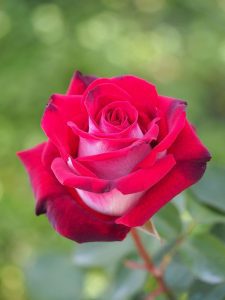
What Is the Osiria Rose?
If you’ve ever seen pictures on the internet or social media of gorgeous rose petals that come in shades of red and pink contrasted with a white reverse, then you probably already know what an Osiria rose is. It is a type of hybrid tea rose that has lovely coloration and a strong fragrance, both of which make it an asset for any garden. Even though many of the pictures you can find online are clearly enhanced for the color to look more intense, the truth is that there is a clear contrast between the exterior of the rose petals and their interior. This type of rose grows in a bush, it has dark-green leaves, and it blooms from June to November. The maximum height of a bush is around 70 inches. The Osiria rose was hybridized in 1978 by Mr. Reimer Kordes of Germany. It was first sold in France, where it was also given the name of Osiria. The species used to create this hybrid are the Tea rose and the Hybrid Perpetual. Currently, it is quite difficult to find the Osiria rose in the United States, and also quite challenging to grow one. This is why many people are unsure whether or not to plant this type of rose, even though they are fascinated by its appearance.How Can You Plant an Osiria Rose?
If what we’ve told you about its unavailability hasn’t tempered your desire to plant your own Osiria roses, then let us take you through the steps that you should follow. First of all, the Osiria rose is quite high-maintenance, and it prefers full sun and well-drained areas. You’re going to have to dig a hole in the ground and then fill it with soil that is rich in nutrients and that will help the rose develop properly. Next, carefully spread the roots of the plant so that they are even. In order for the rose bush to thrive, there is a certain depth that you have to keep in mind. We advise you to keep the stem’s base about 2 inches underground for best results. After you’ve done that, make sure that you fill all the additional space with soil. Then, water the plant at your discretion. The Osiria rose needs plenty of watering, so remember to provide it with water at least two times a week.Osiria Rose Care – Everything You Should Know
As we’ve already mentioned, it can be a challenge to take care of the Osiria rose. The main issue is the fact that this type of rose is susceptible to all kinds of pests and diseases, which is why it rarely comes off as in the pictures you find on the internet. Spider mites, aphids, leafhoppers, and caterpillars are some of the main enemies of the Osiria rose. Also, you should beware of rose rust, black spots, and powdery mildew. Even if you take care of the Osiria rose properly, don’t expect to get a lot of flowers. It is their uniqueness and beauty that draws people in, not the number of blooms it forms. Remember that it also grows quite slowly. This means that you need to have a lot of time and patience in order to get it to bloom.Pruning
That being said, once your Osiria rose bush has developed blooms, you will also have to prune the roses, as you would any other variety. The best season to prune your roses is in spring because that is when the plant actually starts growing. Pruning helps you get healthier and richer blooms. The main trick you should keep in mind is allowing air to circulate through the plant, which is why your roses should all have open centers. Also, try to separate any tangled branches and allow the roses plenty of space to grow and develop unencumbered. If you notice small canes or branches that are drying out, cut them off immediately. This will keep your Osiria rose bush healthy and minimize the possibility of pests impeding its growth. Similarly, as the roses develop and bloom, pay attention to any dead roses that might be hiding amongst the healthy ones. The practice of cutting them off is what specialists call deadheading. It helps the entire plant look better, while also promoting the growth of new blooms.Fertilizing
As any other type of rose, the Osiria rose also needs fertilizing, especially since it is so high-maintenance. We recommend a fertilizer that is created specifically for roses, such as Jobe's Organic Rose & Flower Granular Fertilizer that you can find on Amazon for $15.61. The best time to fertilize your roses is in early spring, but you should also do that in mid-summer. We should mention that even if the Osiria rose requires more care than the typical rose variety, that doesn’t mean that you should overfertilize it. Overfertilization can easily be counterproductive to your efforts. It can cause root injury, fewer blooms, and even result in the plant’s death. This is why you should follow the instructions on the fertilizer package to a tee.Osiria Rose Disease Control
Powdery mildew is one of the most common afflictions of the Osiria rose. This fungal disease tends to prefer moderate temperatures, and usually, begins by attacking the lower parts of the plant. The fungus gets its name from its appearance, with the stems and leaves of the affected plant having white spots that resemble a powder. This can be controlled by chemical fungicides – propiconazole is a popular choice. Two other options are a solution of sodium bicarbonate, or perhaps the most bio-friendly – a 1:10 milk/water solution. All of these options work best by spraying them on the plant in the morning two times per week. The sun will have the opportunity to dry the leaves throughout the day so they are not left moist at night, where the moderated temperature and dampness provide the best dual conditions for powdery mildew to grow. The Osiria rose is also susceptible to black spot. This fungus is also named after its appearance, producing a spattering of black, inky appearing spots on the leaves. As the disease progresses, it will also affect the stems. Unlike powdery mildew, black spot grows best in hotter temperatures. Fortunately, there are multiple synthetic fungicides to choose from – penconazole and mancozeb are two examples. For those who prioritize organic solutions, neem oil rivals the effectiveness of all the synthetics. The optimal treatment schedule is to apply it by spraying every week to ten days during the hottest months of the year. Rose rust is less common than powdery mildew or black spot because most roses have developed a partial resistance to it. However, when it occurs, it is usually in the spring and fall. It leaves rust-colored spots on leaves that will grow larger. A good preventative measure is to clear away leaves that have fallen in the autumn season. Often, pruning out affected leaves will stop the spread. However, if that does not work, fungicides such as tebuconazole and triticonazole will do the trick.Osiria Rose Pest Control
The Osiria rose, like most members of its family, is susceptible to attack by aphids, leafhoppers, spider mites, and caterpillars. One problem with the spider mites and aphids is their small size. Many times, you will not notice their presence until they have already done damage. Fortunately, as with fungal problems, there are several remedies available. One of the fungicides described above, neem oil, also defends against aphids. Horticultural oil acts as an outstanding preventive measure against several of these pests. The chemical imidacloprid, when applied to the soil, is also an effective repellent. The presence of some common rose pests may also attract ants because they eat the honeydew that the pests produce. Therefore, ant colonies will fight to protect these other bugs from beneficial insects that may eat them. A natural ant repellent is peppermint oil. Dilute it in a 1:10 ratio with water and spray just at the base of the rose bush.Where Can I Buy Osiria Rose Seeds?
If you want to buy Osiria rose seeds, but you don’t know where you can find them, we advise you to check online. There, you can usually find Osiria seeds in packs that contain other types of rose seeds as well. For instance, you can purchase packages that contain 5 Different Colors Rare Osiria Roses or Rare Osiria Hybrid Tea Rose Seeds. We highly recommend that you buy osiria rose seeds to add to your garden. They are absolutely stunning and will definitely grab the attention of visitors to your garden. Everyone has roses in their garden, but their roses mostly likely don’t stand out like the osiria rose. Buy some seeds and start planting!
You could also check out Hortico Nurseries, Your Source for Unique Plants… Roses, Perennials, Evergreens, Flowering Shrubs, Cuttings, Grafts, Liners, Fruit Bushes, Vines, & Small Trees. Over 4000 varieties to select from. Located in Canada and shipping worldwide.
We highly recommend that you buy osiria rose seeds to add to your garden. They are absolutely stunning and will definitely grab the attention of visitors to your garden. Everyone has roses in their garden, but their roses mostly likely don’t stand out like the osiria rose. Buy some seeds and start planting!
You could also check out Hortico Nurseries, Your Source for Unique Plants… Roses, Perennials, Evergreens, Flowering Shrubs, Cuttings, Grafts, Liners, Fruit Bushes, Vines, & Small Trees. Over 4000 varieties to select from. Located in Canada and shipping worldwide.
Can the Caring Tips for Osiria Roses be Applied to Growing Peonies as well?
Can the caring tips for Osiria roses be applied to growing peonies as well? It’s crucial to know that both these flowers have distinct needs. While Osiria roses prefer acidic soil and regular pruning, peonies thrive in well-drained soil and require minimal pruning. For a successful growth of peonies, refer to grow peonies: a comprehensive guide for detailed instructions and specific care tips.
Osiria Rose Alternatives
In case you find it difficult to take care of an Osiria rose bush, but you still want to be able to enjoy a similar type of beauty and fragrance, here are some alternatives that require lower maintenance.1. “Love” Rose
The Love rose is quite similar to the Osiria one. This means that the petals also have a more faded exterior. However, the difference is not as visible as in the case of the Osiria variety. The Love rose has deep-red flowers with a silver-white reverse. Moreover, the flowers grow in more than one flush all throughout the season. This guarantees that you will get to enjoy plenty of fragrant blooms.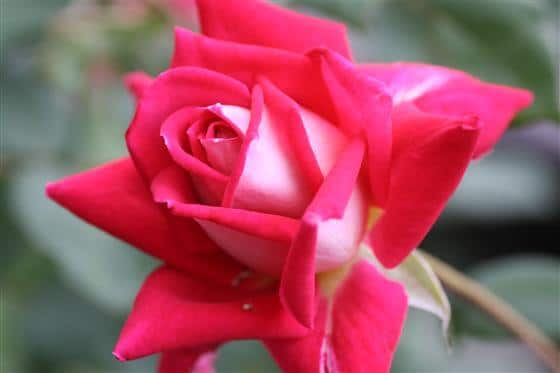
2. “Wekdocpot” Rose
This Grandiflora rose is well-known for its yellowish tone that contrasts with the ruby splashed edges. Its petals are mostly golden-yellow, but the edges are what make this rose variety stand out. The ruby color seeps into the yellow tone wonderfully. Consequently, the resulted blend looks as if someone has powdered the petals with red velvet.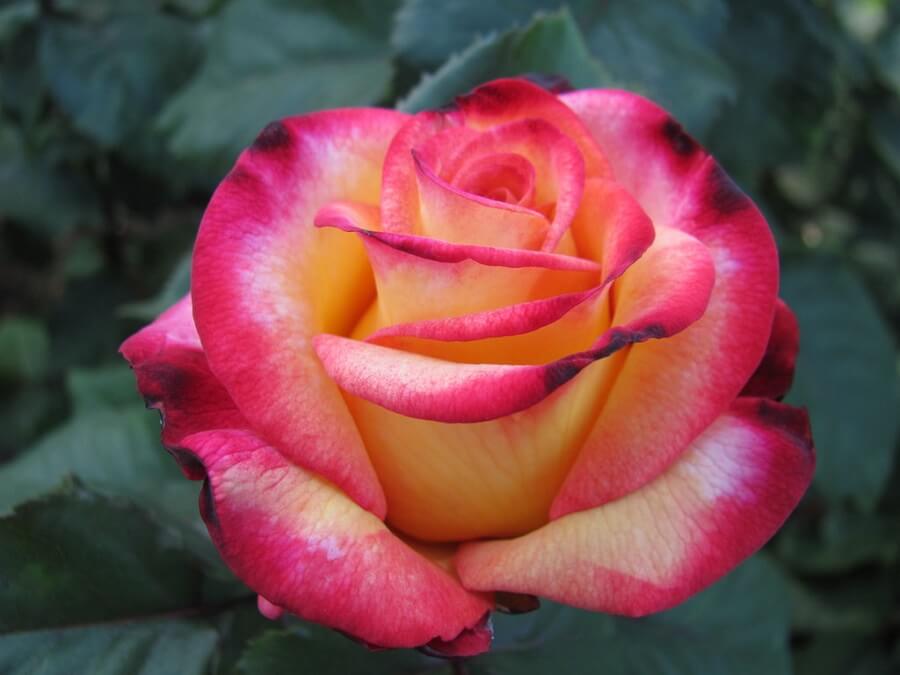
3. “Snowfire” Rose
The Snowfire variety is also quite similar to the Osiria rose, in that the petals also have a white backside. Even though the contrast is not as obvious in the Snowfire rose, its intense red tones definitely make up for it. Furthermore, the roses have a light fragrance and a velvet feel. They will make for a gorgeous addition to any garden.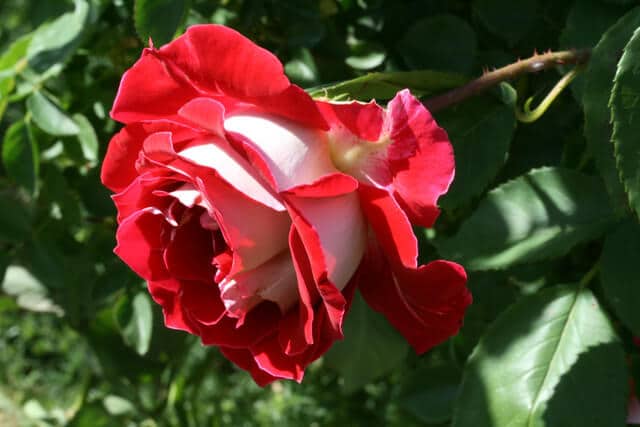
4. “Adacopro” Rose
This is another hybrid tea rose, so it’s quite obvious that it has some similarities to the Osiria rose. While the largest part of the petal is dark-red, the underside of it is not white, as in the case of the Osiria variety, but yellow. So if this sounds like something that you would like to have in your garden, you can always plant some Adacopro roses.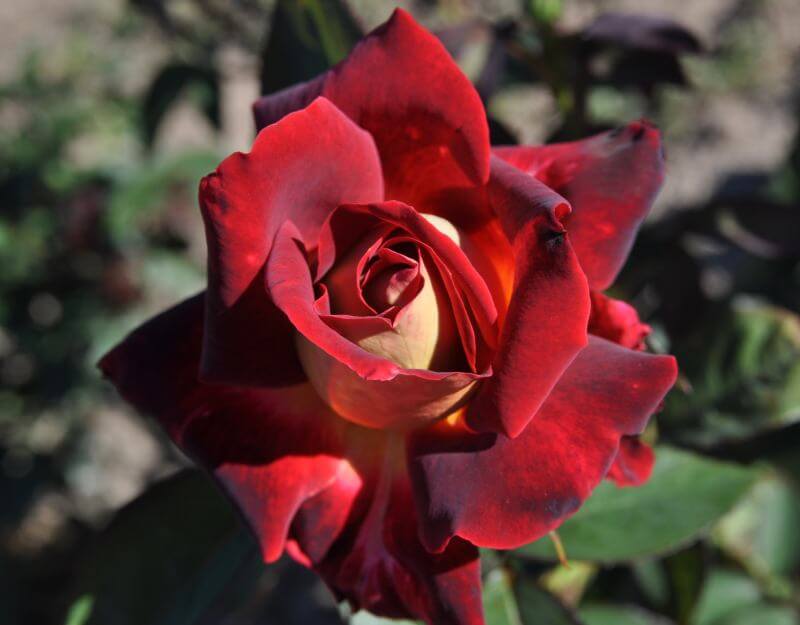
5. “Balprez” Rose
Finally, a rather impressive alternative to the Osiria rose is the Balprez rose. This is truly a treat for the eyes. The petals sport a beautiful mixture of yellow, gold, red, orange, and pink that will delight anyone who plants this rose variety in their garden. The flowers bloom quite heavily, and they do so in tiny clusters.
Summing Everything Up
The Osiria hybrid tea rose, while one of the most spectacular and majestic types of roses that you can plant in your garden, is both quite hard to find and difficult to take care of. However, for people who have more experience with gardening, or for people who enjoy taking risks and rejoicing in the high reward, the Osiria rose is definitely a great option. We must advise you to keep in mind that the end result might not be what you expect since many of the available pictures of the Osiria rose are enhanced. Even so, there’s no denying that this rose is one of the most beautiful ones you can find. You are definitely going to enjoy them in yourd garden, as well as the alternatives we have suggested. For more information about roses and rose care, check out “How to Grow Roses,” as well as “Knockout Roses.” Image source: By T.Kiya from Japan (Rose, Osiria, バラ, オリジア,) [CC BY-SA 2.0 (https://creativecommons.org/licenses/by-sa/2.0)], via Wikimedia CommonsLast update on 2024-04-19 at 04:00 / Affiliate links / Images from Amazon Product Advertising API





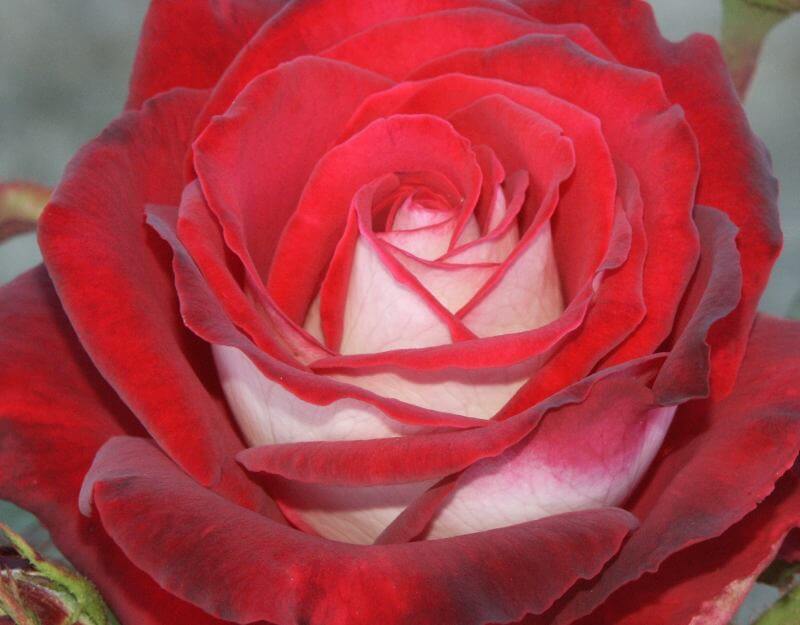


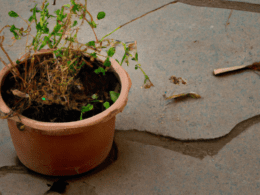
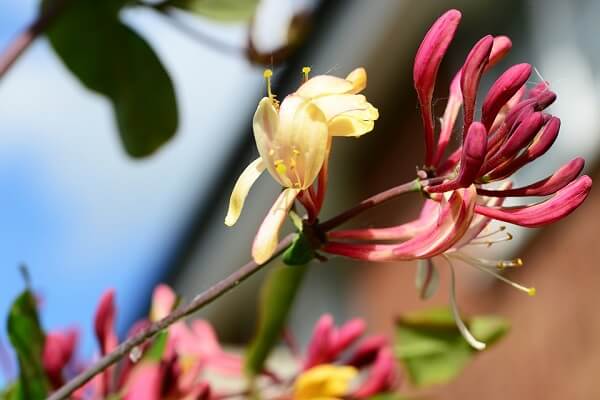
Tying to purchase Osiria roses
The osiria rose has such a beautiful colour. Question – you mentioned applying neem or horticultural oil will help ward off pests. How long does one application last and how often does it have to be applied. Should it be applied immediately after rain as well?
Hello Debbie, great question!
Once the leaves are fully expanded, you can use horticultural oils at any time during the summer. Avoid spraying oils when the temperature is above 90ºF. It is recommended to do it every 7 to 10 days to ensure a steady influx of nutrients.